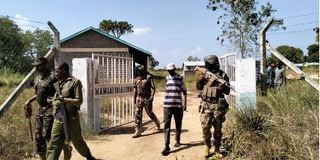Once deserted, Boni forest villages breathe life again nine years later

Kenya Defense Forces (KDF) of the Special Forces unit manning Mangai Primary School in Boni Forest on January 26. Villages in Boni Forest hit the limelight between 2015 and 2019 at the height of frequent Shabaab attacks.
Manisa sub-county which hosts a number of villages in Lamu County is predominantly occupied by the Boni minority community who sought refuge in the area in 2015 at the height of Al-Shabaab attacks in their Mararani and surrounding villages within the terror-prone Boni forest.
Manisa village is about 40 kilometres from Mararani.
Currently, the terror-prone Boni forest villages are breathing life again, all thanks to the improved security owing to the ongoing multi-agency security - Operation Amani Boni.
Between 2015 and 2019, villages like Mararani and Milimani hit the limelight after they were completely deserted following frequent attacks and raids by Al-Shabaab militants.
At Mararani for instance, all the over 80 households that used to reside in the village migrated to Kiunga’s Manisa Village near the Lamu-Somalia border while others sought refuge in Kiangwe, about 50 kilometres away.
A similar situation was witnessed in Milimani village where residents migrated to neighbouring Basuba, Kiangwe, and Kiunga villages.
The situation left the once lively villages haunted and miserable places.
Mararani and Milimani villages became a pale shadow of their former self, with most of the residents deserting their homes.
However, today the situation is different as many residents have returned back to their villages.
Nation.Africa established that the improved security contributed by the ongoing Operation Amani Boni has created trust among the residents.
At Mararani Village, over 45 households out of the 80 that had earlier vacated have already returned.
In Milimani, around 50 households are now living there.
The peace and stability experienced in the Boni Forest villages has in recent times also positively impacted the population with most of the villages, particularly Mangai, Basuba, and Kiangwe witnessing an increase in households and the general population.
Initially, Mangai, the largest village in terms of population in the entire Boni Forest, had 90 households.
Today, the village prides itself on having 115 households according to local administrators interviewed by the Nation this week.
At Milimani, households have increased from 30 to 50 while in Basuba, there are over 60 households.
Kiangwe village used to serve as the host of villagers fleeing insecurity caused by Al-Shabaab from inside Boni forest due to its proximity to the Indian Ocean.
Today, the village has over 130 households.
Ijuu Ware, the chief of Mararani village, noted that more households are willing to come back to the village, particularly if more efforts are made to ensure there is an improved road network, education, health, food and water.
“In Mararani, we’ve more than 100 households but only 45 have come back. Others are in Kiunga and Kiangwe. Plans are in place to bring them back only if the government opens up the Mararani-Sankuri-Kiangwe road since security has been improved. We also appeal for relief food that can sustain these families for at least six months to pave the way for their resettlement,” said Mr Ware.
Khadija Guyo, a resident of Mararani, pleaded with the government and well-wishers to come for their rescue by providing them with iron sheets to enable them to construct houses.
“If we can get at least 3000 iron sheets, all of us here will be sorted. We can cut trees and erect houses by ourselves,” said Ms Guyo.
At Mangai, village headman Abdallah Guri appealed to the state and well-wishers to solve the water and food shortages and the health crisis in the area to enable locals to live comfortably.
“Schools are operational here. The only problem is the water, food and medication. We urge for the equipping of Mangai dispensary to enable us to access medical services from within. Security is no longer a challenge here,” said Mr Guri.
The residents also pushed for the opening of the over 100-kilometre Boni forest-Bar’goni-Hindi road to enable an easy supply of food commodities to their villages.
In a recent visit to Boni Forest, Major-General Juma Mwinyikai, who is the Commanding Officer Eastern Command, pledged to ensure all the concerns pertaining to the state of security, social economics, health, and education of the locals are fully addressed.
“I am happy to hear from the locals themselves that through our efforts as security agencies, peace and stability is being witnessed in Boni Forest. We shall coordinate with the devolved government so that the other challenges still faced can be addressed for the betterment of mwananchi living here,” said Mr Mwinyikai.
The multi-agency security operation in Boni Forest was launched by the national government in September 2015 with the primary objective being to flush out Al-Shabaab militants believed to be hiding in the dense Boni forest.
The operation was initially dubbed ‘Linda Boni’ before undergoing various rebranding to Boni Enclave Campaign, Operation Fagia Msitu, and now Operation Amani Boni (OAB).
Its efforts are majorly centred on stabilizing Lamu County and parts of Garissa, Tana River, Kilifi, and other areas bordering the expansive Boni Forest and towards the Kenya-Somalia border.
It is undertaken by the Kenya Defense Forces (KDF), National Police Service (NPS), Kenya Wildlife Services (KWS), Kenya Forest Service (KFS), and National Government Administration Officers with KDF designated as the lead agency.





